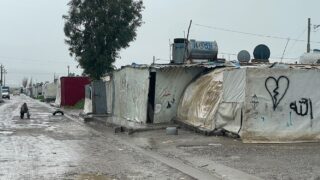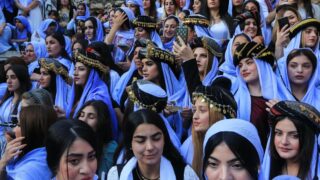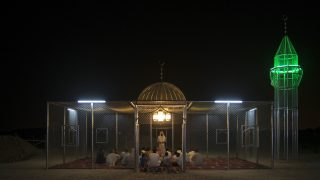The Islamic State-known to Arabs as DAESH-is essentially a product of Saudi Arabian politics and financing, writes Jamal Mohammed Taqi in al-Safir al-Arabi. But has the Saudi state’s strange offspring really become its dark twin, its Nemesis?
Waging jihad against those it considers apostate Muslims is the central religious doctrine of the Islamic State in Iraq and the Levant [DAESH or ISIS]. The principle of jihad against apostates is also the central religious doctrine of the followers of the Wahhabi school of religious jurisprudence.
That is why the school’s partisans [the Saudis]combined sword with banner, faith with power, religious leader with tribal chief, ruling throne with religious guidance, caliphate and imamate. And that is what made the Saudi state’s founders, Mohamed bin Abdel Wahhab and Mohamed Bin Saud, fit together so well, as a sword wears its sheath.
It was this combination which brought to life the state of the al-Saud family, a state which is swathed in the cloak of extremist Wahhabi ideology.
But DAESH is now competing the al-Sauds over who is the most literal and avant-garde exponent of Wahhabi principles. For DAESH, since Islam ‘has no frontiers’, the jihad against apostates can have no frontiers either, for as long as there are people on the face of the planet who do not follow the precepts of Mohamed bin Abdel Wahhab, the imam who declared heretical all other Muslim schools of thought and all other Muslim doctrines, whether Sunni or Shi’ite.
So for DAESH, the Islamic injunction to promote virtue and prevent vice means following the commandments of the caliph, emir or king, who himself believes that the jihad against apostates knows no frontiers, and that faithfully following king or caliph means faithfully following the will of God himself.
In his time, the founder of the Saudi kingdom, Abdelaziz al-Saud, himself warred with extremists from among his own followers, the ‘Ikhwan’ [Brothers], who rose up against him in 1911 and were finally defeated at the battle of Sabilla in 1929. The Ikhwan considered themselves the legitimate heirs of Wahabbism, having withdrawn their allegiance to the [Saudi] caliph when the caliph transgressed the true Wahabbi doctrine.
Abdelaziz al-Saud had first contravened Wahabbi precepts when he drew a frontier for his jihad against the unbelievers. He wanted a kingdom with actual physical boundaries, which took account of the actual balance of power, and thus did not expand into Iraq and Kuwait. On the other hand, the Ikhwan had planned to invade Iraq and Kuwait, which they considered lands of apostates who were not bending to the rules of true Islam.
The DAESH state follows in the same mold, believing that jihad should have neither frontiers nor constraints. It is in direct competition with the al-Saud commanders over who is truly implementing the doctrine [madhhab]that the al-Sauds are supposed to represent.
This doctrine will continue to have schools leaders and followers inside the kingdom as long as the al-Saud family accommodates them. The grand mufti of the kingdom, Abdelaziz bin Abdallah Al-Sheikh is himself a direct descendent of the imam Mohamed Bin Abdel Wahhab, but his public statements and declarations, with their exaggerated support of every policy of the Sauds, have angered other descendents of the imam, who fault the kingdom for being too friendly to the enemies of Islam.
An object of particular anger was the Sauds’ decision to let the American army build permanent bases on Saudi land during the first war against Iraq; but in the present day, there is the policy-also a product of American pressure-barring fighters from joining the war in Syria.
The kingdom’s rulers have long excelled at diverting the energies of their extremist subjects and their calls for jihad: they opened doors for jihad in hot zones far from the kingdom’s frontiers: Afghanistan, India, the Philippines, and they fed sectarian conflicts around the region. Inside the kingdom, matters of personal status were governed by fanatical extremism, and Wahabbi doctrine was elevated to a position of legal tyranny over any other Islamic doctrine.
They installed Wahabbi sheikhs at the head of enormous endowments, controlling giant budgets to satisfy their voracity, while allowing them to rule over the justice system, to promulgate religious rulings, and to be in charge of the thousands of men of the religious police who monitor people, and punish them for slipping from Islamic precepts like praying or covering up.
And on top of it all, at the present day, there are more than 12 thousand Wahhabi Saudis fighting in Syria, while the kingdom turns a blind eye.
In spite of all of this, the rulers of the kingdom are accused being unfaithful to the doctrine.
And so now, the new DAESH form of the Wahhabi jihad finds itself growing inside a readymade structure which could not have been better designed: an enormous ‘doctrinal infrastructure,’ Wahhabi supremacy in all branches of the state, direct support in the educational system and via state employees.
And a DAESH state has grown up right next door to the Saudi version of the Wahhabi state; providing a direct point of comparison: which is more true to the original doctrine?
The original form of Wahabbism-which the Sauds have after all been expounding since they established the Emirate of Diriyah in 1744-has become antiquated, much as the Sauds themselves have become antiquated. Both are fed from the same umbilical cord, and both now face the same difficult choice: renewal or death.
Wahabbism’s new form is now embodied in DAESH. And as for the al-Saud, their technique, which seems to consist of stalling in the middle of the road, seems to have lost its effectiveness. Now that they have announced that they are opposed to DAESH and the terrorost ideology of excommunication and emigration (al takfir wal hijra), they have begun participating in the international coalition that is fighting DAESH; by participating in aerial bombing of DAESH, they can duck the fingers which point at their own responsibility for its rise. But they are doing all this without deciding once and for all what is their new direction; will they be able to outrun both the old and the new Wahabbism?
The al-Saud have long been accustomed to ‘reform’ via diktat, to exchanging calls for a human rights bill for an unending bill of bribes, pouring out wealth and money to smother dissatisfaction. But all of this has evidently and obviously become insufficient to stifle the new competitor; it will neither protect the country any longer from internal dissent nor the nightmare of foreign intervention which the country’s enormous resources and strategic position might inspire.
The first step toward real reform would be for the kingdom to free its political prisoners, all of them. The positive impact would be felt not only by the people of Saudi Arabia, but also by its rulers who wish to continue ruling their country without fearing its people. Moreover, there must be a national reconciliation dialogue with those who have suffered the worst from many decades of sectarian rule that has based its power on discrimination, tribal, regional and doctrinal. A new constitution, an effective one, not like the document that has nominally been in force since 1992, must be drafted, with the input of all the country’s political forces, and submitted to a national referendum. There should be a new high electoral committee to monitor the vote. Elected deputies and local representatives should have real power.
These steps will not lead to success without the belief that they are absolute necessity, a lifeline that can rescue the country from disintegration, turmoil and a revolution that could be open on all possible outcomes.
The forces of religious fanaticism, the ancient and the new, must be shackled. The kingdom must proclaim itself a state respectful of human rights inside and outside the country. Before the country is stricken by the curse of the neo-Wahhabis who want to bring change through their own peculiar ways and the Americans who want a reform that will save their own interests.
The banner of DAESH is more eloquent than that of the ‘true Wahhabis’ of the Saud family; it is without colors or complications: no palm trees or crossed swords. The black of DAESH’s banner represents the world of darkness that has deviated from God’s path and the religion of his prophet, a prophet whose one ring, represented by the flag’s little white circle, will bring the whole world back into divine purity.
The simplicity of the banner echoes the simplicity of the slogans: to be safe, you must become true Muslims: no visits to graveyards, no idolatrous statues, no alienating modernities or complexities. Surrender yourselves to the reality imposed on you by God, says DAESH, this utopian world-a world that simplifies the brain washing operation of its members, whether they are committed fighters or mere lost souls. It is a virtual world that could only be reached by those who commit the most heinous crimes, as if the price of entering the realm of God were the ability to carry out the most hideous of atrocities.
Translated by International Boulevard







